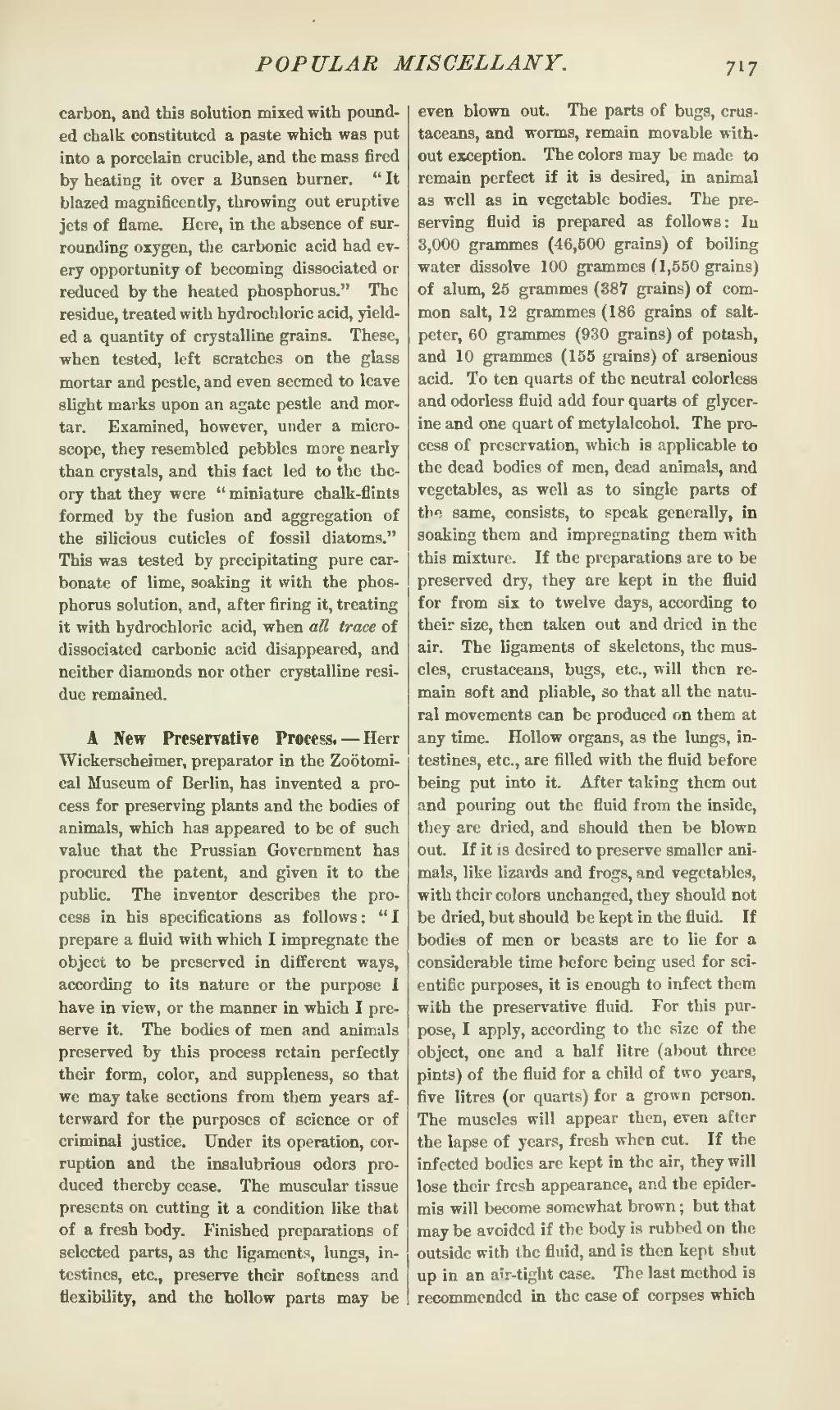carbon, and this solution mixed with pounded chalk constituted a paste which was put into a porcelain crucible, and the mass fired by heating it over a Bunsen burner. "It blazed magnificently, throwing out eruptive jets of flame. Here, in the absence of surrounding oxygen, the carbonic acid had every opportunity of becoming dissociated or reduced by the heated phosphorus." The residue, treated with hydrochloric acid, yielded a quantity of crystalline grains. These, when tested, left scratches on the glass mortar and pestle, and even seemed to leave slight marks upon an agate pestle and mortar. Examined, however, under a microscope, they resembled pebbles more nearly than crystals, and this fact led to the theory that they were "miniature chalk-flints formed by the fusion and aggregation of the silicious cuticles of fossil diatoms." This was tested by precipitating pure carbonate of lime, soaking it with the phosphorus solution, and, after firing it, treating it with hydrochloric acid, when all trace of dissociated carbonic acid disappeared, and neither diamonds nor other crystalline residue remained.
A New Preservative Process.—Herr Wickerscheimer, preparator in the Zoötomlcal Museum of Berlin, has invented a process for preserving plants and the bodies of animals, which has appeared to be of such value that the Prussian Government has procured the patent, and given it to the public. The inventor describes the process in his specifications as follows: "I prepare a fluid with which I impregnate the object to be preserved in different ways, according to its nature or the purpose I have in view, or the manner in which I preserve it. The bodies of men and animals preserved by this process retain perfectly their form, color, and suppleness, so that we may take sections from them years afterward for the purposes of science or of criminal justice. Under its operation, corruption and the insalubrious odors produced thereby cease. The muscular tissue presents on cutting it a condition like that of a fresh body. Finished preparations of selected parts, as the ligaments, lungs, intestines, etc., preserve their softness and flexibility, and the hollow parts may be even blown out. The parts of bugs, crustaceans, and worms, remain movable without exception. The colors may be made to remain perfect if it is desired, in animal as well as in vegetable bodies. The preserving fluid is prepared as follows: In 3,000 grammes (46,500 grains) of boiling water dissolve 100 grammes (1,550 grains) of alum, 25 grammes (387 grains) of common salt, 12 grammes (186 grains of saltpeter, 60 grammes (930 grains) of potash, and 10 grammes (155 grains) of arsenious acid. To ten quarts of the neutral colorless and odorless fluid add four quarts of glycerine and one quart of metylalcohol. The process of preservation, which is applicable to the dead bodies of men, dead animals, and vegetables, as well as to single parts of the same, consists, to speak generally, in soaking them and impregnating them with this mixture. If the preparations are to be preserved dry, they are kept in the fluid for from six to twelve days, according to their size, then taken out and dried in the air. The ligaments of skeletons, the muscles, crustaceans, bugs, etc., will then remain soft and pliable, so that all the natural movements can be produced on them at any time. Hollow organs, as the lungs, intestines, etc., are filled with the fluid before being put into it. After taking them out and pouring out the fluid from the inside, they are dried, and should then be blown out. If it is desired to preserve smaller animals, like lizards and frogs, and vegetables, with their colors unchanged, they should not be dried, but should be kept in the fluid. If bodies of men or beasts are to lie for a considerable time before being used for scientific purposes, it is enough to infect them with the preservative fluid. For this purpose, I apply, according to the size of the object, one and a half litre (about three pints) of the fluid for a child of two years, five litres (or quarts) for a grown person. The muscles will appear then, even after the lapse of years, fresh when cut. If the infected bodies are kept in the air, they will lose their fresh appearance, and the epidermis will become somewhat brown; but that may be avoided if the body is rubbed on the outside with the fluid, and is then kept shut up in an air-tight case. The last method is recommended in the case of corpses which
